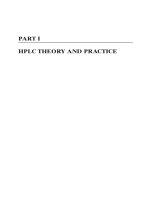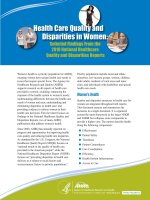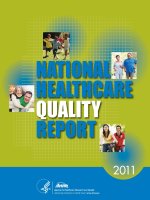National Healthcare Quality Report - part 1 doc
Bạn đang xem bản rút gọn của tài liệu. Xem và tải ngay bản đầy đủ của tài liệu tại đây (5.82 MB, 15 trang )
National Healthcare Quality Report
Highlights
b
Advancing Excellence in Health Care • www.ahrq.gov
Agency for Healthcare Research and Quality
2007
National Healthcare
Quality Report2006
U.S. Department of
Health and Human Services
Agency for Healthcare Research and Quality
540 Gaither Road
Rockville, MD 20850
AHRQ Publication No. 08-0040
February 2008
National Healthcare
Quality Report
2007
National Healthcare Quality Report
Acknowledgments
ii
The NHQR is the product of collaboration among agencies across the Department of Health and Human Services
(HHS). Many individuals guided and contributed to this report. Without their magnanimous support, this report
would not have been possible. Specifically, we thank:
Primary AHRQ Staff: Carolyn Clancy, William Munier, Katherine Crosson, Edward Kelley, Karen Ho, Jeffrey
Brady
, Donna Rae Castillo, and Margaret Rutherford.
HHS Interag
ency Workgroup for the NHQR/NHDR: Hakan Aykan (ASPE), Rachel Ballard-Barbash (NCI),
Erica Ber
ry (HHS-ASPE), Jennifer Bishop (HHS-ASPE), Miriam Campbell (CMS), Steven Clauser (NCI),
Rameicha Cooks (HRSA),
Agnes Davidson (OPHS), John Drabek (HHS-ASPE), Kidus Ejigu (OMH Intern),
Brenda Evelyn (FDA), Laurie Feinberg (HHS-ASPE), Olinda Gonzalez (SAMHSA), Tanya Grandison (HRSA),
Miryam Granthon (OPHS/OMH), Susan Marsiglia Gray (HHS-ASPE), Saadia Greenberg (AoA), Kirk Greenway
(IHS), Suzanne Proctor Hallquist (CDC-NCHS), Lein Han (CMS), Linda Harlan (NCI), Debbie Hattery (CMS),
David Hunt (CMS), Deloris Hunter (NIH), David Introcaso (HHS-ASPE), Steve Jencks (CMS), Linda Johnston-
Lloyd (HRSA), Ruth Katz (ASPE), Cille Kennedy (HHS-ASPE), Richard Klein (CDC-NCHS), Lisa Koonin (CDC-
NCHS), Onelio Lopez (OCR), Leopold Luberecki (ASPE), Diane Makuc (CDC-NCHS), Melisa Mau (OMH
Intern), Marty McGeein (HHS-ASPE), Richard McNaney (CMS), Julie Moreno (OPHS/OMH), Carmen Moten
(NIMH), Leo Nolan (IHS), Karen Oliver (NIMH), Anna Maria Padian (HRSA), Susan Queen (HRSA), Michael
Rapp (CMS), Susan Rossi (NIH), Beatrice Rouse (SAMHSA), Colleen Ryan (IHS), Michael Schoenbaum (NIMH),
Paul Seligman (FDA), Adelle Simmons (HHS-ASPE), Alan E. Simon (CDC-NCHS), Sunil Sinha (CMS), Jane Sisk
(CDC-NCHS), Leslie Shah (HRSA), Phillip Smith (IHS), Emmanuel Taylor (NCI), Wilma Tilson (HHS-ASPE),
Joan VanNostrand (HRSA), Valerie Welsh (OPHS/OMH), Caroline Taplin (HHS-ASPE), Benedict Truman (CDC),
Nadarajen A. Vydelingum (NIH), Odies Williams (OCR), Barbara Wingrove (NCI), and Barbara Wells (NIMH).
AHRQ NHQR/NHDR Team: Jeffrey Brady, Denise Burgess, Cecilia Riv
era Casale, Katherine Crosson, Elizabeth
Dayton, Tina Ding, Denise Dougher
ty, Darryl Gray, Amy Galifianakis, Tracy Henry, Anika Hines, Karen Ho, Jackie
Shakeh Kaftarian, Michael Kaiser, Edward Kelley, Dwight McNeill, Ernest Moy, William Munier, Judy Sangl,
David Stevens, Nancy Wilson, and Chunliu Zhan.
HHS Data Experts: Barbara Altman (CDC-NCHS), Roxanne Andrews (AHRQ), Anjani Chandra (CDC-NCHS),
Frances Che
varley (AHRQ), Steven Cohen (AHRQ), James Colliver (SAMHSA), Paul Eggers (NIH), David Keer
(ED/OSERS), William Mosher (CDC-NCHS), Cynthia Ogden (CDC-NCHS), Robin Remsburg (NCHS), Jane Sisk
(CDC-NCHS), and Marc Zodet (AHRQ).
Other Data Experts: Stephen Edge (Rosewell Park Cancer Institute), David Grant (UCLA Health P
olicy Center),
Michael Halpern (American Cancer Society), Bryan Palis (NCDB, American College of Surgeons), Royce Park
(UCLA Health Policy Center), Stephen Connor (NHCPO), Allison Petrilla (NHCPO), Andrew Stewart (NCDB,
American College of Surgeons), and members of the Interagency Subcommittee on Disability Statistics.
Other AHRQ Contrib
utors: Doreen Bonnett, Cindy Brach, Marybeth Farquhar, Karen Fleming-Michael, Biff
LeVee, Gerri Michael-Dyer, Karen Migdail, Pamela Owens, Mamatha Pancholi, Larry Patton, Wendy Perry,
Deborah Queenan, Mary Rolston, Scott Rowe, Bruce Seeman, Randie Siegel, Christine Williams, and Phyllis
Zucker.
Data Support Contractors: CHD-Fu, Social and Scientific Systems, Thomson Healthcare, and Westat.
This document is in the public domain and may be used and reprinted in the United States without permission. AHRQ
appreciates citation as to source and the suggested format follows:
Agency for Healthcare Research and Quality. 2007 National Healthcare Quality Report. Rockville, MD: U.S. Department of
Health and Human Services, Agency for Healthcare Research and Quality; February 2008. AHRQ Pub. No. 08-0040.
National Healthcare Quality Report
Contents
iii
Chapter Page
Highlights . . . . . . . . . . . . . . . . . . . . . . . . . . . . . . . . . . . . . . . . . . . . . . . . . . . . . . . . . . . . . . . . . . . . . . . . . . . . . 1
1. Introduction and Methods. . . . . . . . . . . . . . . . . . . . . . . . . . . . . . . . . . . . . . . . . . . . . . . . . . . . . . . . . . . 11
2. Effectiveness. . . . . . . . . . . . . . . . . . . . . . . . . . . . . . . . . . . . . . . . . . . . . . . . . . . . . . . . . . . . . . . . . . . . . . . 27
Cancer . . . . . . . . . . . . . . . . . . . . . . . . . . . . . . . . . . . . . . . . . . . . . . . . . . . . . . . . . . . . . . . . . . . . . . . . . . . . 30
Diabetes. . . . . . . . . . . . . . . . . . . . . . . . . . . . . . . . . . . . . . . . . . . . . . . . . . . . . . . . . . . . . . . . . . . . . . . . . . . 39
End Stage Renal Disease (ESRD) . . . . . . . . . . . . . . . . . . . . . . . . . . . . . . . . . . . . . . . . . . . . . . . . . . . . . . 44
Heart Disease . . . . . . . . . . . . . . . . . . . . . . . . . . . . . . . . . . . . . . . . . . . . . . . . . . . . . . . . . . . . . . . . . . . . . . 48
HIV and AIDS . . . . . . . . . . . . . . . . . . . . . . . . . . . . . . . . . . . . . . . . . . . . . . . . . . . . . . . . . . . . . . . . . . . . . 56
Maternal and Child Health. . . . . . . . . . . . . . . . . . . . . . . . . . . . . . . . . . . . . . . . . . . . . . . . . . . . . . . . . . . . 62
Mental Health and Substance Abuse . . . . . . . . . . . . . . . . . . . . . . . . . . . . . . . . . . . . . . . . . . . . . . . . . . . . 69
Respiratory Diseases. . . . . . . . . . . . . . . . . . . . . . . . . . . . . . . . . . . . . . . . . . . . . . . . . . . . . . . . . . . . . . . . . 74
Nursing Home, Home Health, and Hospice Care. . . . . . . . . . . . . . . . . . . . . . . . . . . . . . . . . . . . . . . . . . 81
3. Patient Safety. . . . . . . . . . . . . . . . . . . . . . . . . . . . . . . . . . . . . . . . . . . . . . . . . . . . . . . . . . . . . . . . . . . . . . 97
4. Timeliness. . . . . . . . . . . . . . . . . . . . . . . . . . . . . . . . . . . . . . . . . . . . . . . . . . . . . . . . . . . . . . . . . . . . . . . . 107
5. Patient Centeredness. . . . . . . . . . . . . . . . . . . . . . . . . . . . . . . . . . . . . . . . . . . . . . . . . . . . . . . . . . . . . . . 113
6. Efficiency . . . . . . . . . . . . . . . . . . . . . . . . . . . . . . . . . . . . . . . . . . . . . . . . . . . . . . . . . . . . . . . . . . . . . . . . 121
List of Core Report Measures. . . . . . . . . . . . . . . . . . . . . . . . . . . . . . . . . . . . . . . . . . . . . . . . . . . . . . . . . . 131
Appendix
es:
Data Sources
Measure Specifications
Data Tables
2007 National Healthcare Quality Report—At A Glance
The quality of health care in this Nation continues to improve at a modest pace. However, the rate
of improvement appears to be slowing. The average annual rate of improvement reported across
the core measures included in this year’s fifth annual National Healthcare Quality Report
(NHQR) is 2.3%, based on data spanning 1994 to 2005. An analysis of selected core measures,
which cover data from 2000 to 2005, shows that quality has slowed to an annual rate of 1.5%.
An important goal of improving health care quality is to reduce variation in care delivery across
the country. This means that patients in all States would receive the same level of high quality,
appropriate care. Since 2000, on average, variation has decreased across the measures for which
the NHQR tracks State data, but this progress is not uniform. For example:
•
The percentage of heart attack patients who were counseled to quit smoking has increased
from 42.7% in 2000-2001 to 90.9% in 2005. Moreover, 48 States, Puerto Rico, and the
District of Columbia all performed above 80% on this measure in 2005.
•
Yet, in 2000, diabetic patients in the worst performing State versus the best performing State
were admitted to the hospital 7.6 times more often with their diabetes out of control. By
2004, this difference had doubled to 14. If all States had reached the level of the top four
best performing States, at least 39,000 fewer patients would have been admitted for
uncontrolled diabetes in 2004, with a potential cost savings of $216.7 million.
One of the key functions of the NHQR is to track the Nation’s progress in providing safe health
care. Five years after the first NHQR, and 7 years after the Institute of Medicine’s landmark
publication To Err Is Human, it is still difficult to document prog
ress, although more information
than ev
er now exists on patient safety. From 2000 to 2005, patient safety improved at an annual
rate of only 1%.
Measuring efficiency in health care is complex and often depends on one’s perspective. This
NHQR offers an initial evaluation of efficiency at the national level, providing several data-based
perspectives on its possible measurement. There is still much room for progress in advancing the
development of better measurement tools that can help assess whether Americans are obtaining
true value in health care.
National Healthcare Quality Report
iv
National Healthcare Quality Report
Highlights
1
Key Themes and Highlights From the National Healthcare
Quality Report
Since 2003, the Agency for Healthcare Research and Quality (AHRQ), together with its partners in the
Department of Health and Human Services (HHS), has reported on progress and opportunities for improving
health care quality. With this fifth annual National Healthcare Quality Report (NHQR), these reports will
have provided more than 50,000 data points about health care quality in the United States. Has it made a
difference? Have Federal and State governmental agencies, provider organizations, insurers, and employers
made progress in improving health care quality and safety? While every previous release of the NHQR has
attempted to summarize the direction in which health care quality is going, this fifth report tries to summarize
the progress that has been made and the remaining challenges to improve health care quality in this Nation.
The NHQR is built on 218 measures categorized across four dimensions of quality—effectiveness, patient
safety, timeliness, and patient centeredness. This year’s report focuses on the state of health care quality for a
group of 41 core report measures that represent the most important and scientifically credible measures of
quality for the Nation, as selected by the HHS Interagency Work Group.
i
The distillation of 41 core measures
for the 2007 report provides a more readily understandable summary and explanation of the key results
derived from the data.
ii
While the measures selected for inclusion in the NHQR are derived from the most
current scientific knowledge, this knowledge base is not evenly distributed across health care. The analysis in
the following pages centers on measures for which data are available from the baseline year of 2000 or 2001
and the comparison year of 2004 or 2005.
Three themes that emerge from the 2007 NHQR emphasize the need to accelerate progress in achieving high
quality health care:
•
Health care quality continues to improve, but the rate of improvement has slowed.
•
Variation in quality of health care across the Nation is decreasing, but not for all measures.
•
The safety of health care has improved since 2000, but more needs to be done.
i
The HHS Interagency Work Group, which represents 18 HHS agencies and offices, was formed to provide advice and
support to AHRQ and the National Reports team.
ii
Data on all NHQR measures are available in the Data Tables Appendix at www.ahrq.gov/qual/measurix.htm.
Health Care Quality Continues To Improve, But the Rate of Improvement Has Slowed
For the past 5 years, the NHQR has summarized trends in health care quality. This is a difficult undertaking,
as there is no single national health care quality survey that collects a standard set of data elements from a
uniform population over the same time period. Rather, data are available from a wide range of sources that
focus on different populations and data years.
In order to track the progress of health care quality in this country, the NHQR presents an annual rate of
change in quality, which represents how quickly the health care system is making improvements across the
report’s core measures. Another way to describe this is the speed of improvement in the U.S. health care
system. Based on these core report measures, quality of care continues to improve. However, the rate of
improvement seems to be slowing.
Figure H.1. Median rate of change overall and by care setting, 1994-2005 and 2000-2005
Note: Available data years for the 1994-2005 analysis vary
based on the specific measure, as not all measures have data
for every data year. Details on the measures included in these
rates of change are presented in the NHQR Measure
Specifications Appendix.
•
The annual median rate of change for all core measures, which span the years 1994 to 2005, is 2.3%
iii
(Figure H.1).
•
More recently, the rate of improvement has slowed. From 2000 to 2005, the annual median rate of
change for measures with available data was 1.5%.
•
As reported in last year’s NHQR, however, most measures show some improvement. Of the 41 core
measures reported above with data that span 1994 to 2005, 27 improved, 6 declined, and 6 are unchanged.
iii
Not all data sources provide data for each year from 1994 through 2005: 1994 is the earliest data year for any data source
reported in the 2007 NHQR Data Tables Appendix, and 2006 is the latest data year for any data source reported in the 2007
NHQR Data Tables Appendix.
National Healthcare Quality Report
Highlights
2
0.0
0.5
1.0
1.5
2.0
2.5
3.0
3.5
A n
n
u
a
l
p e
r
c
e
n
t
c
h
a
n
g
e
2.9
C
o
r
e
M
e a s
u
r
e s
1
99
4
-
2
00
5
(
n
= 4 1
)
2.8
1.7
0.8
1.5
2.3
H
o s
p
i t
a l
(
n =
82
)
H o
m e
H
e a l t h
( n
=
14
)
A
m b
u
l
a t o
r
y
C
a r
e
(
n =
88
)
L o n g - T
e r
m
C
a r
e
(
n =
19
)
C
o
r
e
M
e a s
u
r
e s
2
00
0
-
2
0
05
(
n
=
19
)
M
e a s
u
r
e
c a t e g
o
r
y
1994 -
2
005
National Healthcare Quality Report
Highlights
3
When examining change across multiple diseases and care settings, it is difficult to understand why changes in
performance occur. In the analysis of trends for this year’s NHQR, it is clear that some areas have shown
increasing rates of improvement while others have slowed. For example, the rate of improvement in heart
disease treatment increased from 3.3% to 5.6% (1994-2005 versus 2000-2005). However, the rate of
improvement in diabetes slowed from 1.2% to 0.6%. Initiatives such as public reporting and strong advocacy
from multiple stakeholders in support of quality are circumstances that may influence broad system change
and subsequent quality improvements in certain areas. However, these data show that sustaining a steady rate
of improvement over time is a challenge.
Variation in Quality of Health Care Across the Nation Is Decreasing, But Not for All
Measures
One goal of quality improvement efforts nationally is to reduce differences in health care quality that patients
receive in one State versus another. There is no justification, for example, for a patient hospitalized for a heart
attack in California to have different care than a patient in Alabama. Yet, analyses from the NHQR, its
companion National Healthcare Disparities Report (NHDR), other organizations, and the health care literature
in general have shown that the quality of care that patients receive varies significantly across the country. This
variability is evident in multiple dimensions, according to many different factors, such as social and
demographic characteristics of patient populations, hospital types (e.g., urban, rural, teaching, non-teaching),
and different clinical areas (e.g., heart disease, pneumonia, clinical preventive services).
1, 2, 3
For the past 20 years, a central focus of quality improvement efforts has been to bring care for all patients to a
minimum quality standard based on evidence.
4
Reporting on unwarranted variation across States in health
care quality has been part of past NHQRs. The NHQR is a rich source of information on quality of care
across the 104 measures for which State level information is available. This year’s NHQR examines whether
progress is being made at reducing variation in care for the time period 2000 to 2005.
iv
More measures have seen progress in terms of decreases in variation between the best performing State and
the worst performing State between 2000 and 2005. Specifically:
•
Variability decreased for 28 measures.
•
Variability increased for 13 measures.
•
There was no change for 18 measures.
For example, there has been progress in standardizing high quality care across the country, such as the
percentage of heart attack patients given smoking cessation counseling while in the hospital (Figure H.2).
iv
In the past, the NHQR has presented variation in health care quality by showing measures with high ratios between the
best and worst performing States. To examine whether variation was increasing, this year’s NHQR examined these ratios
across the 59 measures for which State data were available for 2000-2001 to 2004-2005 and for which the same States
provided data for both data years. Then analysis was conducted to determine whether more measures had seen increases or
decreases, or whether the ratio of best to worst State had not changed. Data were analyzed for measures on which the same
States reported data for both time periods in order to ensure that appropriate comparisons were made across the same States
across time.
Figure H.2. Percentage of heart attack patients given smoking cessation counseling while hospitalized, by State,
2002 and 2005
National Healthcare Quality Report
4
Highlights
68.4—55.7
50.5—45.9
55.6—50.7
DC
Percentage of patients
PR
2
002
44.8—20.8
55.7 or higher
DC
Percentage of patients
PR
2005
•
In 2002, nationally, heart attack patients admitted to hospitals were counseled about quitting smoking less
than 50% of the time.
•
In 2002, the rate at which heart attack patients in hospitals were counseled to stop smoking by their
doctor in the best performing State was 3.3 times higher than the rate for their counterparts in the worst
performing State.
•
However, over just 3 years, most States improved their performance on this measure. The latest national
data (2005) show that heart attack patients admitted to hospitals are now counseled to quit smoking 91%
of the time.
•
In addition, the variation across the country on this measure has decreased. Figure H.2 shows that all
States in 2005 had reached the level of the best performing States in 2002. In 2005, only two States were
below 80% on this measure.
Although overall variation has decreased slightly, many of the measures with the most variation—that is,
where patients are treated very differently based on the fact that they are in a different State—have not
improved since the first NHQR. Moreover, if all States were able to achieve the highest State’s performance
even on these measures alone, it would mean significant advances in terms of patient care and outcomes. For
example:
•
In 2002, chronic care nursing home residents were restrained 8.3 times more frequently in the worst
performing State than in the best performing State. In 2006, this ratio increased to 10. If all States had
reached the average of the best performing State in 2006, at least 61,500 fewer residents would have been
physically restrained nationwide.
•
In 2000, diabetic patients were admitted to the hospital with uncontrolled diabetes 7.6 times more often in
the worst performing State than in the best performing State. By 2004, this difference had nearly
doubled, with uncontrolled diabetes admissions per 100,000 population in the worst performing State 14
times higher than in the best performing State. If all States had reached the level of the four best
performing States in 2004, almost 39,000 fewer patients would have been admitted for uncontrolled
diabetes, with a potential cost savings of $216.7 million.
•
While some States may never be able to achieve the performance of the top States because of differences
in their population’s health risks, we know from this analysis and from other research that considerable
costs,
5, 6, 7
are incurred as a result of hospitalizations and other health services that are potentially
avoidable.
National Healthcare Quality Report
Highlights
5
The Safety of Health Care Has Improved Since 2000, But More Needs To Be Done
For 5 years, the National Healthcare Quality and Disparities Reports have presented a snapshot of the safety of
health care provided to the American people. This analysis has been based on an emerging set of databases
that were created to respond to the need for information documented in such publications as the Institute of
Medicine’s landmark 2000 report To Err Is Human.
8
Today a clearer picture of trends in health care safety is
only beginning to emerge. In part, this results from the intense complexity required to accurately assess and
ensure complete reporting on medical errors and patient safety events.
Key databases developed to date that have enhanced the current knowledge base on patient safety nationally
include the Medicare Patient Safety Monitoring System, AHRQ’s Healthcare Cost and Utilization Project’s
Patient Safety Indicators, and the National Nosocomial Infections Surveillance System.
v
While these have
been developed or expanded only in recent years, results from these efforts contribute to the trends that can be
drawn from the 5 years of reporting on patient safety in the NHQR.
v
Data sources for patient safety information contained in the National Healthcare Quality and Disparities Reports:
• The Quality Improvement Organization Program, Centers for Medicare & Medicaid Services.
• The Medicare Patient Safety Monitoring System, Centers for Medicare & Medicaid Services.
• The Healthcare Cost and Utilization Project, AHRQ.
• The National Nosocomial Infections Surveillance System, a cooperative, nonfinancial relationship between hospitals
and the Centers for Disease Control and Prevention.
National Healthcare Quality Report
6
Highlights
Figure H.3. Median annual rate of change in quality by measurement area, 2000-2005
•
Safety improved slightly between 2000 and 2005 at an annual rate of 1% improvement (Figure H.3).
•
However, during that same time period, other areas of health care improved at significantly greater rates,
with care for heart disease improving at 5.6% during this time and care across all measures with available
data improving at nearly double the rate of improvement for safety.
•
Areas where significant attention has been concentrated, such as the appropriate timing of antibiotics for
surgery and reducing medication errors, have shown progress. Specifically:
Over 30% more patients received appropriate timing for antibiotics before and after surgery in
2005 than in 2004.
From 2004 to 2005, adverse drug events from warfarin and low-molecular-weight heparin
declined 21% and 28%, respectively.
Deaths following complications of care declined 2.4% from 1994 to 2004.
However, in many areas, a fraction of the information necessary to track patient safety effectively is available,
and, in most cases, clinicians still lack basic monitoring information on medical errors and adverse events.
9
For example:
•
Only 25 of 41 safety measures in the full NHQR measure set have data available for tracking recent
trends (2000 to 2005).
•
No national data systems currently report data on safety at a State or local level.
•
Because adverse events and medical errors are rare events from a statistical perspective, it is difficult,
using current data, to compare across time or patient groups in order to examine potential causes and
possible solutions to safety issues.
National Healthcare Quality Report
Highlights
7
0
1
2
3
4
5
6
M
e
d i
a
n
r a
t
e
o
f
c
h
a
n
g
e
1.9
A
l
l
S
el
ec t
ed
M
ea s
u
r
es
( n
= 1
17
)
5.6
3.6
1.5
H
ea r
t
D i
s
ea s
e
(
n =
16
)
1.0
0.6
C a n c er
( n
= 1
5
)
M
a t
er n
a
l
a n
d
C h
i
l d
H
ea l
t
h
(
n =
12
)
S a f
et y
( n
=
25
)
D i
a b et
es
( n
=
9
)
M
e
a
s
u r e
m e
n t
A
r
e
a
National Standards, Neighborhood Solutions
The NHQR continues to present a broad examination of health care quality in the United States. As noted
above, while quality continues to improve across most measures, the pace of change has slowed.
Improvements have been demonstrated in such areas as patient safety and care for certain diseases and
populations. However, these improvements have not been realized across all populations or across the entire
country. Moreover, even in areas where progress has occurred, significant effort is needed to ensure that
adequate systems are in place to track progress and use the data for improvement.
A number of major efforts have begun to accomplish this goal of using data for improvement. Specifically:
The President signed the Patient Safety and Quality Improvement Act of 2005 (Patient Safety Act) to spur
the development of voluntar
y, provider-driven initiatives to improve the quality, safety, and outcomes of patient
care. The Act, which will be implemented by AHRQ and the HHS Office for Civil Rights, addresses many of
the current barriers to improving patient care. All too often, health care providers fear that if they participate
in the analysis of medical errors or patient care processes, the findings may be used against them in court or
harm their professional reputations. The reluctance of providers to participate in improvement initiatives,
combined with the difficulty of aggregating and sharing data confidentially across facilities or State lines,
limits our current ability to aggregate data in sufficient numbers to identify rapidly the most prevalent risks
and hazards in the delivery of patient care, their underlying causes, and practices that are most effective in
mitigating them.
The Patient Safety Act addresses these barriers to improvement through the following goals and mechanisms:
•
Encourage greater health care provider participation in improvement initiatives by establishing strong,
nationally uniform confidentiality and privilege protections for the patient safety information that these
initiatives assemble or develop.
•
Expand the analytic expertise that is available to health care providers to analyze safety and quality issues
by encouraging the formation of new patient safety organizations (PSOs) with which providers can
voluntarily work.
•
Improve our ability to rapidly recognize and address the underlying causes of risks and hazards to patient
care by facilitating the aggregation and analysis of large numbers of patient safety events.
The Patient Safety Act directs the Secretary to develop regional and national statistics and trends for reporting
in future NHQRs. AHRQ will carry out these activities on behalf of the Secretary and is required to develop
this information through the aggregation and analysis of non-identifiable patient safety data that PSOs,
providers, and others voluntarily contribute to a network of patient safety databases that the statute envisions.
Creating ways that data can be used for benchmarking and improvement is a key step in driving quality
improvement. AHRQ’s State Snapshots Web tool was launched in 2005. It is an application that helps State
health leaders, researchers, consumers, and others understand the status of health care quality in individual
States. The 51 State Snapshots—for every State plus the District of Columbia—are based on 129 quality
measures, each of w
hich evaluates a different segment of health care performance and shows each State’s
strengths and weaknesses. Although the measures are the products of complex statistical formulas, they are
expressed on the Web site as simple, five-color graphical “performance meters.” The State Snapshots provide
summaries that measure health care quality in three different contexts: by type of care (such as preventive,
acute, or chronic care), by setting of care (such as nursing homes or hospitals), and by clinical area (such as
care for patients with cancer, diabetes, or respiratory diseases). After selecting a State on a national map,
users can view whether that State has improved or worsened compared with other States in a particular area of
National Healthcare Quality Report
8
Highlights
health care delivery. The 129 measures range from preventing bed sores to screening for diabetes-related foot
problems to providing antibiotics quickly to hospitalized pneumonia patients. The State Snapshots also allow
users to compare a State’s performance against that of other States in the same region and to see how a State
compares against best performing States.
The release of this year’s State Snapshots is complemented by the launch of NHQRnet and NHDRnet, a pair
of new, interactive Web-based tools for searching AHRQ’s storehouse of national health care data. These
online search engines allow users to create spreadsheets and customize searches of information in the NHQR
and NHDR.
Efforts To Improve Measures and Data
The measures and data used in these reports come from a variety of sources within HHS and elsewhere.
Performance measures are central to ongoing efforts to improve the quality of care within this country. Yet,
despite progress in quality improvement, a number of challenges remain related to the current state of the
science in the performance measurement field, including the following:
•
Inadequately developed measures that lack reliability and validity can lead to inaccuracies in determining
the presence or absence of quality.
•
The existence of multiple and, at times, conflicting performance measures that are neither uniform nor
standardized may cause confusion.
•
Measure maintenance is an issue as the evidence base of measures is refined and expanded.
•
The burden of data collection for performance measurement is a growing concern.
Efforts by HHS to address these and other concerns related to improving performance measures and data have
been ongoing. For instance, results of validation studies for measures, including field testing, expert panel
review, focus group testing, and the like, have provided insights that significantly contributed to measure
refinement and, in other cases, demonstrated the reliability and accuracy of the existing performance measures.
Research that develops new scientific evidence has also contributed to the improvement of measures and can
provide fruitful avenues for measure development. Agencies within HHS have also worked with a number of
stakeholders, such as measure developers, consumers, purchasers, various quality alliances, and the National
Quality Forum, to come to consensus around a core set of measures that can be used to report quality. This
collaboration helps to harmonize measures and provides a forum for discussions on the current state of
measurement. A key area is identifying gaps that, if filled, will provide a comprehensive picture of
performance in health care. Another key area is identifying state-of-the-art methods, such as risk adjustment
methodologies, that can enhance performance measures to provide an unbiased representation of quality.
HHS is also exploring other opportunities to reduce the burden of collecting the data necessary for
performance measurement and quality improvement activities. Of particular interest is research that explores
cost-efficient approaches to data collection, such as standardization of common data elements contained in the
electronic health record. These data elements may enhance existing performance measures, making them
more reliable and accurate. They also can make performance data collection a useful and automatic byproduct
of the care delivered rather than an independent activity. This change can enable doctors, nurses, and other
health care professionals to spend more time caring for patients.
Performance measurement is a tool for continuous quality improvement, and the broad areas cited above depict
some of the continuing activities HHS is currently supporting in its efforts to improve and enhance the quality
of care delivered within the United States.
National Healthcare Quality Report
Highlights
9









